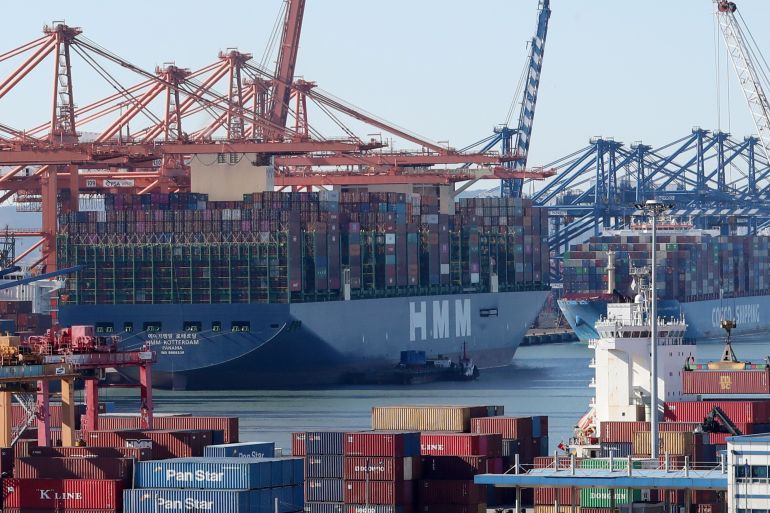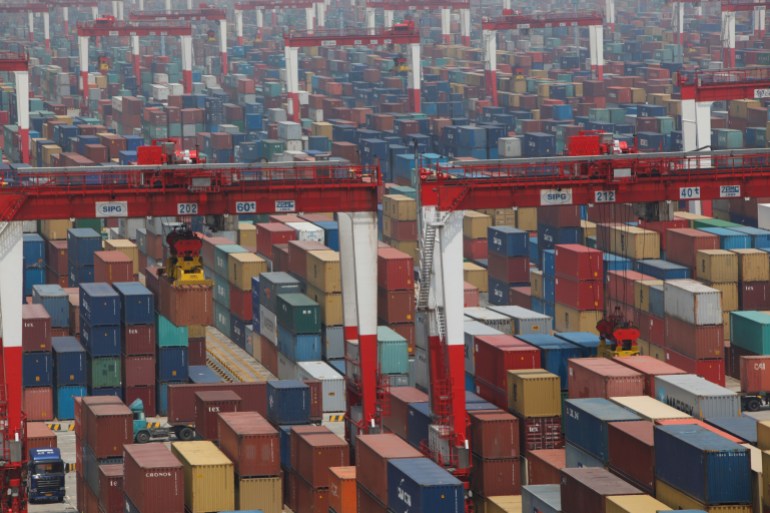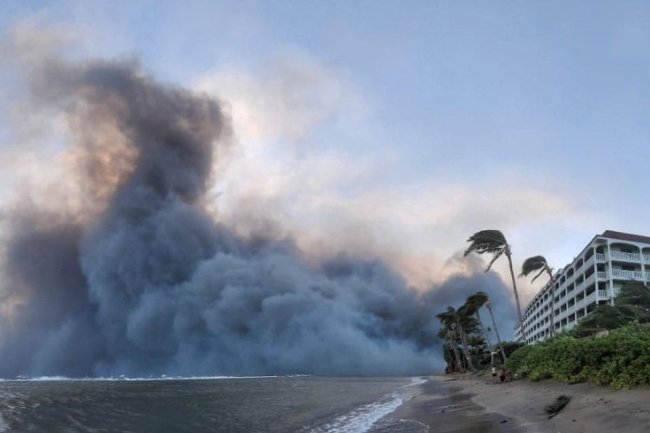Global shipping regulator underwhelms with new emissions targets
To move goods, freight ships burn roughly 300 million metric tonnes of dirty bunker fuel each year, producing 3 percent of global greenhouse emissions [File: Yonhap/ EPA-EFE]At its marine environment protection committee meeting last week, the International Maritime Organization (IMO) agreed to new shipping emissions targets to keep global temperature rises below 1.5°C (2.8°F) by mid-century, in line with the 2015 Paris Agreement. The proposal was panned by climate activists who said the targets didn’t go far enough. The United Nations-backed agency, and de facto regulator of global shipping, first adopted measures to reduce greenhouse gas emissions in 2011. But last week’s pledge – which reinforced previous targets – was designed to achieve net-zero emissions “by or around” 2050. Until now, the shipping industry lacked a commitment to net zero, which will be achieved when no new additional greenhouse gasses are released into the atmosphere. The IMO’s decision follows on the heels of l


At its marine environment protection committee meeting last week, the International Maritime Organization (IMO) agreed to new shipping emissions targets to keep global temperature rises below 1.5°C (2.8°F) by mid-century, in line with the 2015 Paris Agreement. The proposal was panned by climate activists who said the targets didn’t go far enough.
The United Nations-backed agency, and de facto regulator of global shipping, first adopted measures to reduce greenhouse gas emissions in 2011. But last week’s pledge – which reinforced previous targets – was designed to achieve net-zero emissions “by or around” 2050.
Until now, the shipping industry lacked a commitment to net zero, which will be achieved when no new additional greenhouse gasses are released into the atmosphere.
The IMO’s decision follows on the heels of last month’s global finance summit. Convened by French President Emmanuel Macron, its meetings focused on loss and damage funding for developing countries through, among other things, levies on global shipping.
While attempts to raise climate financing through carbon taxes were dismissed for now, the IMO’s climate strategy did agree to “indicative checkpoints”, which aim to reduce the carbon intensity of shipping fuels by 20 percent in 2030, as compared to 2008 levels.
Intensity refers to the emissions produced per cargo relative to distance. The document also refers to “striving” for targets of a 30 percent reduction by 2030 and an 80 percent cut by 2040, adding that near-zero fuels should make up 5 percent of shipping’s energy mix by the end of the decade.
Conservationists have criticised the plan as toothless and vague. In a public statement, Mark Lutes of the World Wildlife Fund (WWF) said “the shipping industry regulator has left the sector with targets and measures off course for emissions reductions at the scale and pace needed”.
Several Pacific Island IMO-member states have also pointed out that, to be consistent with net zero by 2050, a 36 percent emissions cut should have been agreed by 2030 (with a 96 percent reduction by 2040).
Big emitter
Shipping accounts for 80-90 percent of global merchandise trade, by volume. To move these goods, freight ships burn roughly 300 million metric tonnes of dirty bunker fuel each year, producing one billion tonnes of CO2 – equivalent to 3 percent of global greenhouse emissions.
The shipping industry will have to halve emissions by 2050 to stay within the limits of the Paris Agreement’s 1.5°C (2.8°F) global heating (compared to pre-industrial levels) target.
In recent years, the trend has been in the opposite direction – between 2013 and 2018, shipping emissions rose by 10 percent, according to the latest data available.
While industries like road transport and power have started to address their carbon footprints, shipping remains heavily reliant on fossil fuels. Critics say that shipping has been slow to decarbonise due to insufficient industry regulation.
“Shipping companies operate across multiple jurisdictions, so determining appropriate regulations is complicated. And they take advantage of that,” said Carlos Bravo Villa, a policy expert at OceanCare, a marine conservation NGO. “But things are changing,” he added.
“Shipowners travelling through European waters will soon be taxed for their pollution,” he said, referring to the inclusion of shipping in the European Union’s emissions trading scheme from 2024. “Still, it’s disappointing that a levy wasn’t agreed at a global level.”
Moreover, he said, IMO’s 2030 emissions pledge is “simply inconsistent” with net zero by 2050. “[The] 2030 reductions should have been closer to 40 percent”, he said.

For their part, some shipping companies have started changing their business practices voluntarily.
“The industry has recently seen the introduction of fuel optimisation standards, on-board solar electrification and even wind-powered technologies,” said Rasmus Bach Nielsen, head of global fuel decarbonisation at Trafigura, a commodity trading firm.
CMA CGM, the world’s third-largest shipping company, finalised an order of 12 carbon-neutral methanol ships in April. One of its chief rivals – Maersk – took delivery of the world’s first container ship powered by green methanol on July 10.
“The 2050 net-zero target is great,” noted Trafigura’s Bach Nielsen. “It will encourage low-carbon fuels and … with a significant carbon pricing agreement, we can make green fuels viable and have a realistic chance of coming close to Paris alignment.”
He stressed that full decarbonisation will only take place after the introduction of a greenhouse levy, which he expects in 2025. He also suggested that shipping companies have the “skill and capacity” to tackle the financial and practical implications of a carbon tax.
Missed opportunity?
According to Jan Hoffmann, chief of Trade Logistics at the UN Conference on Trade and Development, it’s “very unfortunate” that a carbon levy was not agreed. “Those funds could have been used to support poor countries in dealing with extreme weather events,” he said.
The failure to reach an agreement “will also further delay the [green energy] transition and lead to additional costs in the future, when shipping will need to decarbonise even faster,” Hoffmann told Al Jazeera.
A handful of emerging market economies opposed the levy. Countries like Brazil and China, both of which have large shipping industries, argued that a carbon tax would shift the responsibility of historical emissions from wealthy nations onto shipping companies.
Developing nations, however, were not united in their opposition. A group of Pacific nations led by the Marshall Islands backed a shipping levy of $100 per tonne of emissions. According to Reuters news agency, the proposal would have raised up to $100bn per year.
“The Solomon Islands’ proposal could have generated many possibilities,” Hoffmann said. Options discussed at last week’s meeting included investments in low-income country hydrogen power, “green” physical infrastructure and port maintenance.
For now, the IMO’s emissions reduction targets are designed to accelerate the energy transition by lowering the cost – through tax breaks and subsidies – of clean relative to dirty fuels. Until then, emissions reduction targets will raise the cost of goods traded by sea.
“And that’s to say nothing of transforming infrastructure at ports to accommodate these changes,” added Hoffmann. “That said, price increases for consumers will be small compared to the impacts of climate change.”
Last week’s meetings succeeded in aligning shipping emissions targets with the Paris climate accords. But for Carlos Bravo Villa of OceanCare, “IMO should be paving a clearer and quicker path for shipping decarbonisation. For now, marine life remains in grave danger.”
What's Your Reaction?

















